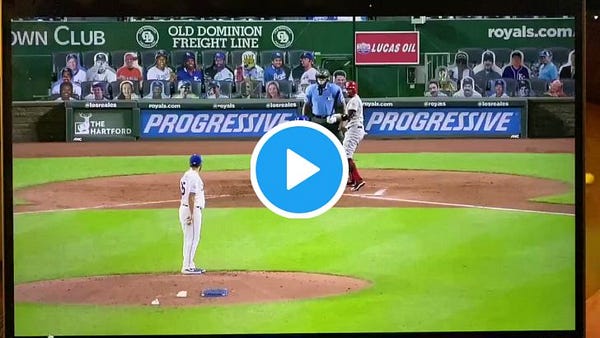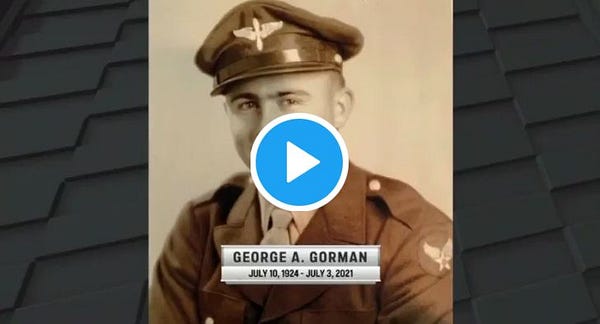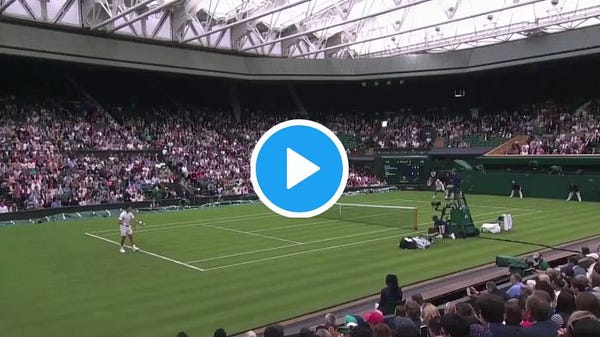Shot Selection and Offensive Rebounding, Morikawa, Booker, Castellanos, and UFC 264
Optimal Shot Selection and Offensive Rebounding
Across sports leagues, analytics have contributed to the evolution of playing styles. One of the clearest examples is the trend towards three-point shooting in the NBA, mostly at the expense of the mid-range two-point shot. Simple analysis shows that you are expected to score more points on a three-pointer versus a long two-pointer:

Twenty years ago, teams averaged under 15 three point attempts per game; today, teams average close to 35 three point attempts per game. The numbers in the above table indicate that a three-point attempt averages more than 0.25 expected points above a long two-point attempt, but I want to focus on how that number understates the benefit of shooting threes.
In evaluating the expected points of an NBA possession, we should not stop at evaluating the expected points of a shot. Rather, we should include the expected additional points that will result from extra shots via an offensive rebound. Let’s say a team averages 1 point per shot attempt, makes 50% of their shot attempts, and secures an offensive rebound on 20% of missed shots. To approximate the expected points of a possession, we could build a rough equation like:
The above equation is oversimplified intentionally, but the point is that offensive rebounds increase a team’s expected points per possession. As you raise the probability of an offensive rebound (0.2 in the equation above), you raise the expected points per possession. This begs the question: Do some shots result in offensive rebounds at a higher rate than other shots?
It’s a question I’ve been mulling over for a while, so I decided to dig into it a bit this week. My intuition was that longer shots will produce more misses that bounce far out (“long rebounds”), which should result in more rebounds for the offensive team. At PBPStats.com, they have manually charted 4,000 shots from the 2019-20 season for a sampling of games. Here are the results:

The intuition turns out to be true: Shots from three-point distance produce offensive rebounds at a higher rate than long two-point attempts. So while the explicit benefit of shooting a three-pointer versus a long two-pointer might be around 0.25 points, there is an additional benefit in increasing your probability of getting an offensive rebound, which widens the 0.25 points advantage.
I strongly suspect that NBA front offices are cognizant of this dynamic when building teams and deciding rotations. Take the Milwaukee Bucks, for example, who are structured around Giannis Antetokounmpo. Giannis is a 7-foot freak athlete and one of the Bucks primary ball handlers. He shoots poorly from long range, but he is an elite rebounder. The Bucks front office has surrounded Giannis with players who shoot proficiently (and frequently) from long range.
So when Giannis drives to the basket and passes out to a three-point shooter, the explicit benefit is that the Bucks are attempting a valuable shot, a shot with high expected points attached to it. But there’s an additional benefit: Giannis will be near the basket and available for an offensive rebound if the shot is missed. I think Milwaukee ranking 4th in the NBA in offensive rebounds per game is connected to this.
On the other hand, I’m physically pained watching Giannis attempt long-range shots. Not only is Giannis a poor shooter, but he is also the best rebounder on the court for the Bucks and when he shoots from long range, the Bucks are rarely positioned well for an offensive rebound. Opposing teams invite Giannis to shoot:

Does it look like somebody in a green jersey will get the rebound if Giannis misses this shot?
I suspect there is an edge in understanding the relationship between shot location and personnel/player positioning on the court, with an eye towards offensive rebounding and creating extra possessions. Player tracking data is increasing in availability and popularity across sports leagues; I’m sure NBA front offices are utilizing that data to research topics like this.
This is a small thing I’ll be observing during the NBA Finals, which start this week featuring the Milwaukee Bucks and the Phoenix Suns. As someone who is pulling for Phoenix, I hope Giannis (once he is healthy) settles for outside shots.
Separation and Morikawa
If my life depended on beating a professional golfer in one round of golf, which golf course should I choose? Well if my goal were to maximize my happiness for the last round of my life, I’d probably select Pinehurst No. 2. But if my goal is to maximize my chances of beating somebody who is far more talented than I am, the factors are much different.
I’ve written before about the concept of separation, a fundamental element of understanding where players will excel or underperform. The more that a golf course separates talent, the more a leaderboard will reflect skill. Inversely, the less a golf course separates talent, the more a leaderboard will reflect randomness. Detroit Golf Club, which hosted this past weekend’s Rocket Mortgage Classic, creates little separation between players. It’s not a coincidence that eleven players finished within three strokes of the winning score, and many of these players were longshots entering the tournament.
So in choosing a course to compete against a professional golfer, I would select a course like Detroit Golf Club that fails to create much separation in an expected score between a good shot and a bad shot. As a massive underdog, I want randomness.
This concept is relevant for PGA Tour players! The best players in the world do not compete every week; they schedule their tournaments selectively. Golfers should be scheduling tournaments that maximize their chances of winning. With this in mind, let’s look at how leaderboard separation impacts the 4th best player in the world, Collin Morikawa.
Collin Morikawa is currently the best ball-striker in the world. In other words, he consistently performs at the top of the world from tee to green, which includes all shots except for putts. So where should we expect Collin Morikawa to play his best relative to his competitors? We’d expect his best finishes at the golf courses that create the most separation in scoring from tee to green. These are golf courses where there is a significant difference in scoring between a good shot and a bad shot.
I do not have data for every single course played on the PGA Tour (namely Augusta National), but of the data I have since the beginning of 2019, Morikawa has played at 7/8 of the events that create the most separation tee to green. Here’s how he finished in those tournaments:
Three top-two finishes in seven events is exceptional. When a course repeatedly offers Morikawa chances to separate himself through his ball striking, he will finish near the top of leaderboards with regularity.
At the individual tournament level, I can assure you that over the next decade, Collin Morikawa will register more top finishes at Muirfield Village Golf Club. At a more macro level, you can expect the best ball-strikers in the world to thrive on golf courses that offer a reward to high-quality shots and a stiff penalty to low-quality shots.
Keeping Prices in Sync - Follow Up
Three weeks have passed since I wrote about a modern challenge sportsbooks face in setting prices. A sportsbook must keep all markets in sync, which is especially challenging for highly correlated bets. The example I’d offered at the time:
The Phoenix Suns are listed at +550 (15.4%) to win the NBA Finals. Devin Booker, the clear superstar for the Suns, is listed at +900 (10%) to win Finals MVP. How probable is it that the Suns win the Finals and Booker is not the Finals MVP?
And then I alluded to making a large bet on Devin Booker to win Finals MVP. I had made the bet because I wanted to bet on Phoenix winning. The bet on Booker seemed like a better price for betting on Phoenix’s success than betting directly on Phoenix. Well, here we are a few weeks later and the Suns are favorites in the NBA Finals, listed around -185 (65%).
Following a stellar Western Conference Finals performance, Suns guard Chris Paul (+175: 36%) is now the favorite to win Finals MVP and Devin Booker is second (+240: 29%). So I guess the answer to “How probable is it that the Suns win the Finals and Booker is not the Finals MVP?” is: higher than I thought…
Deep Fly Balls by Castellanos
I can’t believe this just happened.
About a year ago, Nick Castellanos hit a home run in the middle of a broadcaster’s apology for using a homophobic slur. It resulted in one of the funniest sports videos in recent memory:
Somehow, Nick Castellanos did it again last night:
Forget Barry Bonds, Nick Castellanos is the greatest home run hitter in the history of baseball.
UFC 264
This upcoming Saturday features an exciting UFC card. For those of you who do not watch UFC fights, I can appreciate the lack of enthusiasm for violence. I love the UFC because the viewing experience is incredible. It’s obvious how intensely each athlete has trained, and the commentators effectively provide insight into what you are watching, which is a refreshing change of pace compared to other sports like golf.
Since context always enhances the viewing experience, here are a few reasons to be excited for the main card.
Sean O’Malley puts on an exciting display every time he fights. His scheduled opponent, Louis Smolka, withdrew at the beginning of last week due to a staph infection. The UFC needed someone to take the fight with O’Malley on short notice and Kris Moutinho answered the call. He’s a massive underdog against O’Malley.
A reader sent me this video about Stephen Thompson’s fighting style. I always appreciate understanding a fighter’s strengths and weaknesses when watching a fight. Thompson is fighting in the penultimate fight of the night.
Conor McGregor, one of the most entertaining UFC fighters of all-time, headlines the main event against Dustin Poirier. This is their third time squaring off in the Octagon, and Saturday will decide the tiebreaker, as each guy has beaten the other once. The winner of this fight will likely earn a chance at a title fight against Charles Oliveira.
Saturday night will be a fun one.
Feedback/Contact
Email: Joseph.LaMagnaGolf@gmail.com
Twitter: @JosephLaMagna
Other Content I Enjoyed this Week
Long-time ESPN NBA reporter Rachel Nichols got caught with a hot mic. Here’s the soundbite and here’s the NYT article explaining the drama. In terms of stories I like to discuss with friends, this checks a lot of boxes.
Novak Djokovic and Roger Federer are a couple wins away from squaring off in the Finals at Wimbledon. Check out this Djokovic game from a match last week:
Kevin Van Valkenburg’s piece about taking his daughter to watch Simone Biles compete








